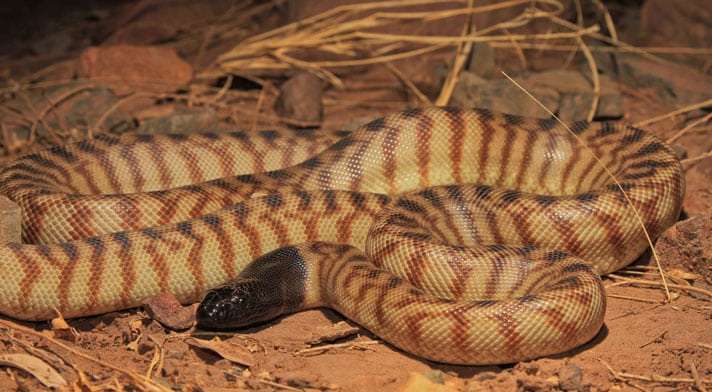
Description:
Scientific name: Aspidites melanocephalus
Life span: 20-30 years
A. melanocephalus adults normally reach lengths of 1.5–2 m (4.9–6.6 ft) in total (including tail), however they can reach heights of up to 3.5 m. (11 ft). The tail tapers to a tiny point, and the body is muscular with a flattened appearance.
Large, symmetrical scales cover the top of the head. At midbody, there are 50–65 rows of smooth, glossy dorsal scales, whereas 315–355 rows of ventral scales are present. The anal scale is solitary, while the subcaudal scales on the tail range from 60 to 75. The posterior subcaudals frequently split in an atypical manner.
Black, dark gray, brown, gold, and cream hues are organized in a banded or brindled pattern throughout the color pattern. The tummy is pale in hue with darker patches scattered throughout. Shiny black color covers the head and many inches of the neck and throat.
A. melanocephalus is a terrestrial species that frequently inhabits areas with loose debris and rocks. It hisses loudly when startled but won’t likely bite unless pursuing prey. Although it occasionally attacks with a closed mouth, it is usually manageable. Despite being a good swimmer, it is hardly ever seen in the water. It isn’t poisonous.

Native Region/Habitat
With the exception of the extremely arid areas, Australia’s northern half is home to the species A. melanocephalus. Queensland, Australia’s “Port Denison Bowen” is the type of locale mentioned. It thrives in semiarid to humid tropical environments.
Behavior:
The Black-headed Python only sticks its head out of its burrow, never exposing its body to the sun to warm it and expose itself to predators. Its entire body is heated by the black head, which serves as a solar panel. This nocturnal snake kills its prey by coiling around and suffocating it, just like other pythons do.
Care As a pet/In captivity:
The placid attitude and eye-catching color pattern of A. melanocephalus have made it a highly sought-after exotic pet. It is bred in captivity and is reasonably easy to buy, although it is expensive. Potential owners should take all appropriate enclosure, temperature, and food requirements into account because this snake may grow quite large and be quite a muscular snake.
- Babies of black-headed pythons can begin their lives in tanks as little as 15 gallons. You can expand the enclosure’s size after 8 to 12 months.
- The hot side basking area should be between 89 and 95 degrees. For newborns, place one hide there and another on the cool side. Usually, adults don’t need a hide. The cool range can be defined as 75 to 80 degrees. During the night, the ambient temperature might drop as low as 72 degrees. Both a basking light and a heat pad beneath the tank are smart additions. The heat pads, which are located on the hot side, are typically covered with a hide.
Table





